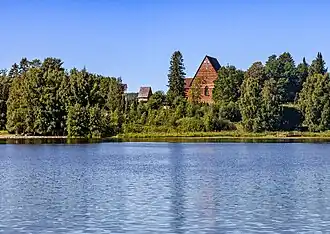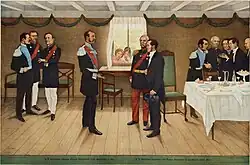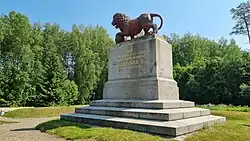Parola (Hattula)

Parola is an urban area located in the municipality of Hattula in the Tavastia Proper region of Finland. It is notable for its rich history that intertwines ancient settlement, medieval culture, and significant military heritage. Parola has a population of 6,678 as of 2022 and it is the centre of Hattula.[1][2]
Early History and Settlement
The area around Parola, including Hattula, has been inhabited since prehistoric times, with settlements dating back to the Stone and Iron Ages. Archaeological finds and manors around Lake Vanajavesi point to a deep-rooted manor culture in this region.[1]
Medieval Period
.jpg)
Parola means word in Latin and Italian. The name Parola apparently comes from the fact that in the Middle Ages, Parola served as a spiritual center for the entire Häme region.[3]
Hattula, including Parola, was part of the historic Häme region from the late 13th century under Swedish rule. The medieval heritage of Hattula is anchored by the Holy Cross Church (Pyhän Ristin kirkko), built primarily of brick in Gothic style between the late 1400s and early 1500s. This church served as an important pilgrimage site during the Middle Ages, attracting visitors for its medieval frescoes and rich religious significance. The Church of the Holy Cross in Hattula became the easternmost pilgrimage site of the Catholic Church in Northern Europe. The Church of the Holy Cross in Hattula became even more popular when author Anneli Kanto wrote the book The Saint of the Rats, which tells the story of the nuns who painted the church's frescoes..[3][1][4][5]
Military


Parola's military history is a defining aspect of its identity. Parolannummi in Parola has been used as a military training ground since 1777, but its military tradition dates to the 17th century when infantry and cavalry troops were assembled during the Thirty Years’ War. Swedish Kings Gustav III and Gustav IV Adolf observed military exercises at Parolannummi. After the transfer of Finland to the Russian Empire in 1809 after the Finnish War, Russian Emperors Alexander I and Alexander II also visited the area.[1]
The most historically significant event occurred in 1863 when Emperor Alexander II met with Senator Johan Vilhelm Snellman at Parolannummi. This meeting led to the decree that elevated the Finnish language to equal status with Swedish in the Grand Duchy of Finland. To commemorate this, a bronze statue called the "Lion of Parola," created by Swedish sculptor Andreas Fornander, was erected in 1868.[1][6]
Modern Era
.jpg)
.jpg)
Parola is the center and administrative seat of the municipality of Hattula. It is home to most of the municipality’s services, such as the municipal hall, schools, the library, and commercial services. Parola is also officially classified in statistics as part of the Hämeenlinna urban area, but in practice it serves as Hattula’s administrative center. Parola is located with good transport connections, including a motorway and a railway.[7]
Today, Parola hosts the Finnish Defence Forces' Armour Brigade and the Parola Armour Museum. The museum, established in 1961, showcases a large collection of armored vehicles and honors the history of Finnish armored and anti-tank troops. The Parola Armour Museum has a wide selection of American, German, French, Russian, and British tanks. The "Lion of Parola" remains a symbolic monument featured also on the flag of the Finnish Army’s Armour School.[1][8]
Cultural and Regional Importance
Hattula as a whole, including Parola, features historical manors, religious sites, and cultural institutions. The Holy Cross Church continues to be a significant architectural and historical landmark, while Parola is recognized for its military heritage and as a center of Finnish language history.[1]
See also
References
- ^ a b c d e f g Mäntylä, Eero (1976). Hattulan historia - History of Hattula. The Municipality of Hattula.
- ^ "Taajama- ja haja-asutusalueväestö iän ja sukupuolen mukaan kunnittain, 2022". Tilastokeskus. Retrieved February 2, 2024.
- ^ a b Olof, Af Hällström (1974). Hattulan Pyhän ristin kirkko [Hattula Holy Cross Church] (in Finnish). Hattulan seurakunta - Hattula Parish.
- ^ "Rottien pyhimys on tuplannut Hattulan Pyhän Ristin kirkon kävijämäärät – kirjailija Anneli Kanto kertoo tarinan 1500-luvun Hattulasta". Yle Uutiset (in Finnish). 2022-08-05. Retrieved 2025-08-13.
- ^ Virolainen, Antti (2021-06-12). "500 vuotta vanhat kirkon seinämaalaukset ovat tämän kesän turistihitti – suosikkikirjan lukijat haluavat nähdä ne omin silmin". Ilta-Sanomat (in Finnish). Retrieved 2025-08-13.
- ^ "Tämä leijona ei pure, vaikka sitä rapsutetaan". Yle Uutiset (in Finnish). 2011-08-25. Retrieved 2025-08-13.
- ^ "Maalaistaajamasta halutaan kuntalaisten olohuone, joka houkuttelee myös matkailijoita". Yle Uutiset (in Finnish). 2014-06-23. Retrieved 2025-08-13.
- ^ "Parolan Panssarimuseossa voi sihtailla aidon tykin takaa, onnistuisiko panssarivaunun pysäyttäminen". Yle Uutiset (in Finnish). 2021-06-21. Retrieved 2025-08-13.